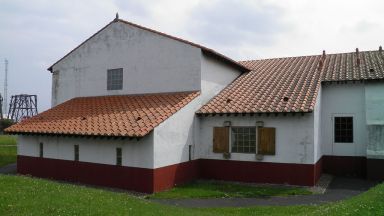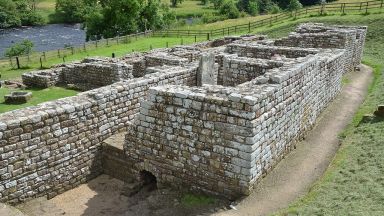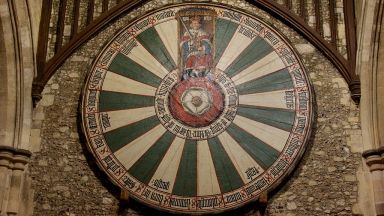Pons Aelius
Roman Site in Newcastle upon Tyne
Pons Aelius was a Roman auxiliary castrum or fortified camp and also Roman settlement at the original eastern end of Hadrian’s Wall, close to the center of present-day Newcastle upon Tyne, England. It was the second link in the fortress chain of Hadrian’s Wall and was occupied between the 2nd and 4th centuries AD.
It was part of the chain of fortresses on Hadrian’s Wall ( per lineam valli ), which consisted of 16 forts , secured its eastern section and a bridge over the River Tyne. The camp was used by the Roman military for about 300 years, probably from 122 to 400 AD. Nothing remains of the fort and the bridge today.
Where does the name the very name Pons Aelius come from?
The ancient name of the military site, Pons Aelius was recorded in the Notitia dignitatum, a directory of the late Roman administration from the 4th century. Pons means bridge in Latin and Aelius is attributed in dedication to Emperor Hadrian, Hadrian’s family Nomen or ‘clan name’ was Aelius. So it means “Bridge of Aelius”. It was almost certainly used for the fort and the camp village as well. The river was called tinea by the Romans.
Where is the fort of Pons Aelius in Newcastle?
The fort stood west of Segedunum ( Wallsend ) and Arbeia ( South Shields ), north of Concangis (Chester-le-Street), and east of Condercum ( Benwell ) and Coriosopitum ( Corbridge ). The bridge and the fort stood at the northern end of today’s Cade’s Road, which in turn lies over a former Roman road. It is believed that it led from Brough-on-Humber, via Eboracum ( York ) to Concangis . There were also a number of small streams (Pandon Burn, Ouse Bourne, Skinner Burn, Lort Burn) that flowed into the Tyne near or directly by the fort. One was passed directly through a culvert under the wall.
The fort was located on a hill above the north bank of the river, today covered by buildings in the city center, the Norman castle of Newcastle (Castle Keep) and the remains of an Anglo-Saxon church, which is said to have been built in part from stones from the wall. The praetorium and principia of the Hadrianic fort at Pons Aelius were recently found in the grounds of the castle adjacent to the Castle Keep, the castle being built directly upon the site of the former Roman encampment.
Originally built c.AD122 to mark the eastern terminus of the Wall, the fort at Newcastle is quite small and was sited here to guard the important river-crossing, the first major encampment being nearby at Condercum (Benwell, Tyne & Wear).
The fort was abandoned around 400 AD and the site was built on by the Anglo-Saxons. Excavations in the 1970s to 1990s found over 600 Anglo-Saxon graves.
Aelian Bridge
The site of the Aelian Bridge was discovered in 1872 lying directly beneath the swing-bridge built in that year. This bridge still exists, carrying Bridge Street across the Tyne, lying betweeen the modern road-bridges of the B1307 to the west and the A167(M) to the east. The Roman road led directly south by south-east from the southern end of the bridge, beneath the modern buildings, taking the line of West Steet beyond, and did not follow the course of the Bottle Bank and Gates Head roads.
The Roman bridge had two stone abutments and, although only two piers have so far been located, it is estimated that there were originally ten. The pier found in 1872 was 16 feet wide and 20 feet long with cutwaters both upstream and down to cope with the tidal nature of the Tyne at this point in its course. The pier caisson was constructed from closely-set, iron-shod oak piles, with the internal space filled with stone rubble. The total length of the Roman bridge from bank to bank is estimated to have been 735 feet.
There are a number of small tributary streams of the Tyne which must have passed through culverts beneath the Wall. The Pandon Burn emptied into the Tyne some 150 yards downstream from the Roman bridge near the Custom House, and the substantial Ouse Bourne confluence lies over ¾ mile further downstream. Another small stream named the Skinner Bourne entered the Tyne just over 300 yards upriver from the site of the Roman bridge beyond the Mansion House, and another named the Lort Burn lay to the east about 1/3 of the distance between the Pandon and Ouse Burn confluences.
Who Built Pons Aelius?
Vexillations or divisions of three British legions Legio secundae Augusta (“the second legion of Augustus “), Legio sextae Victrix (“the sixth legion, the victorious”), Legio vicesimae Valeria Victrix (“the twentieth Valerian legion, the victorious”) were probably stationed here temporarily for construction work. According to the inscription on the Neptune Altar, they were under the command of the governor Gnaeus, who fought insurgents in northern Britain around 158.
Leg VI Victrix is mentioned on two altarstones dredged up from the Tyne, one dedicated to Oceanus and the other to Neptune, both powerful water deities.
“For Imperator Antoninus Augustus Pious, Father of his Country, detachments for the Second Augustan Legion, the Sixth Victorious Legion and the Twentieth Legion Valiant and Victorious
contributed from the two German provinces (built this), under Julius Verus, Legate of the emperor with pro-praetorian power.” (RIB 1322; dated: c.AD155-159)
The Garrisons of Pons Aelius
2nd century AD – A cohort of auxiliary troops that had been set up in Lower Germany under Emperor Trajan. The unit donated an honorary inscription to the Empress Julia Domna . It has been detectable in Britain since 103 and could originally have been between 480 and 500 men strong ( quingenary ). It is believed to have existed for almost four centuries. It is unclear whether they also had cavalrymen in their ranks.
Early 3rd Century – Cohors Ulpia Traiana Cugernorum civium Romanorum – The Cohort of Ulpian Cugerni, Trajan’s Own
A dedication to emperor Hadrian’s mother, Domitia Paulina, attests the presence of the Cohors Ulpia Traiana Cugernorum civium Romanorum (The Cohort of Ulpian Cugerni, Trajan’s Own) as being stationed at Pons Aelius at the beginning of the third century. The unit was originally recruited from the Cugerni tribe of the Lower Rhine in Germany. The governor Gaius Julius Marcus is thought to have been in office sometime around AD213, the year after emperor Septimius Severus, Julia Domna’s husband, died at York.
“For the most noble Julia Augusta, mother of Marcus Aurelius Antoninus, and of the encampments, and of the senate, and of the fatherland. Out of loyalty and devotion under the direction of Gaius Julius Marcus the pro-praetorian legate of the emperor, the First Cohort of Ulpian Cugerni, Trajan’s Own, citizens of Rome, have placed this.” (RIB 1322c; base; dated: c.AD213; Britannia xi (1980), p.405, no.6)
4th century AD – Cohors Primae Cornoviorum – The First Cohort of Cornovii
The Cornovians are unique among indigenous units in that, unlike the rest of the British cohorts, they were stationed in their homeland. The Cornovian (or Kornen) people settled in what is now the counties of Cheshire and Shropshire , north-west England. Their metropolis was Viroconium Cornoviorum (Wroxeter), near Shrewsbury . It is the only known British unit posted to Hadrian’s Wall. It probably stood on the wall until the Romans withdrew or the provincial army was dissolved in the 5th century. From the Notitia Dignitatum , troop list of the Dux Britanniarum , the rank of its commanding officer, a tribunus, is known for the Ponte Aeli of the 4th century.
The Pons Aelius appears in our Complete Guide to Visiting Newcastle upon Tyne!
This website uses affiliate links which may earn a commission at no additional cost to you!
Visiting Pons Aelius
Nearby Attractions
- Newcastle Castle (0.0) km
Castle in Newcastle upon Tyne - Bessie Surtees House (0.1) km
Historic Building in Newcastle upon Tyne - St Nicholas Cathedral (0.1) km
Cathedral in Newcastle upon Tyne - Historic Quayside (0.2) km
Area in Newcastle upon Tyne - Literary and Philosophical Society of Newcastle upon Tyne (0.2) km
Historic Building in Newcastle upon Tyne - The Tyne Bridges (0.3) km
Bridge in Newcastle upon Tyne - Theatre Royal, Newcastle (0.4) km
Theatre in Newcastle upon Tyne - Edwardian Central Arcade (0.5) km
Historic Site in Newcastle upon Tyne - Grainger Market (0.5) km
Market in Newcastle upon Tyne - Hadrian’s Wall – Milecastle 4 – Westgate Road (0.5) km
Roman Mile Castle in Newcastle upon Tyne



